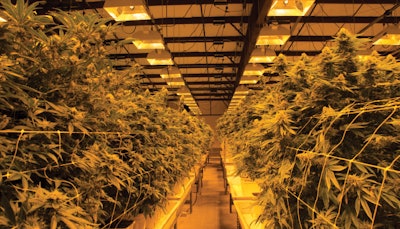
Established in 2015, Oregon Bud Company (Oregon BC) is an offshoot of Telluride Bud Company, established in 2012 in Colorado. With a successful operation in Colorado under their belt, founders Gary and Yolanda Davis were paying close attention to Oregon and the future of cannabis in the state. In 2015, they decided to open their own production facility there, and approached Eli McLean—who, at the time, was a master grower for another company in Colorado—for his insights on developing the growing environment and to invite him to take the position as the lead cultivator at their new facility.
“Gary told me that he wanted me to come out to Oregon and see the new building that they had purchased,” McLean says. “I was amazed by the size of the building; it was 28,000 square feet with 20-foot-high ceilings. I saw this huge blank canvas and instantly became excited about the opportunity.”
Almost immediately the conversation shifted to climate control and creating an environment in which the plants would best respond, specifically air-conditioning units that could do both dehumidification and CO2 administration. “We wanted a sealed environment; I don’t like exchanging air from the outside, no matter how clean it gets,” McLean says. “I believe that a controlled sealed loop is the best environment for a successful cannabis production facility.”
The building was a highly insulated, huge metal structure, providing the perfect framework for a full-scale commercial facility. The key was finding both the manufacturer and the equipment that could support their vision. To find the right firm, Oregon BC provided their business objectives, including the projected square footage of the garden and the bloom room. “The engineering firm considered several factors including the maximum outdoor temperature, inflation, canopy size and number of lights to best determine the amount of cooling required,” says McLean.
When designing their system, Oregon BC built in 30-percent redundancies, which included 130 tons of cooling in the bloom room, and 30 tons of cooling in the vegetative room. Having these redundancies in place ensured that they had the right environment to support their full-scale operation, even in the case of an HVAC failure. The redundancies were specifically designed so that if they lost a unit, the production facility could continue to run at full capacity. “It may seem overboard, that is until we hit 104 degrees for a few days,” says McLean. “It was amazing to see how these units keep up with the demand, and when one unit went down, it was essentially a non-issue.”

Another factor that a lot of growers tend to downplay the importance of is dehumidification, stresses McLean. There is no question that there are outdoor growers who grow plants in areas where humidity is high, McLean says, but these growers will tend to avoid particular strains, due to the increased risk of disease. Having a dehumidification system, with units that are equipped to extract up to 225 gallons of liquid a day, ensures that Oregon BC can support the plants’ varying humidity requirements. In the bloom room, Oregon BC likes to maintain the level at 45-percent humidity to keep botrytis at bay. While in the vegetative room, the humidity level is slightly higher, at around 60 percent. The higher humidity level helps promote new leaf growth, which is particularly beneficial for cloning.
Oregon BC’s climate control machines are also equipped with carbon dioxide supplementation, which monitors the carbon dioxide level and then dispenses the necessary amount into the air stream. Next to nutrients and lights, McLean believes that carbon dioxide supplementation is the most important factor in the garden. This is particularly relevant in the bloom room, where Oregon BC pumps up the CO2 level to 1,200 to 1,400 parts per million. “The machines keep the CO2 level extremely steady, maintaining the higher level in the blooming rooms, and a lower level while the plants are in the vegetative state,” McLean says. (For more information on CO2 supplementation.)
However, McLean emphasizes that CO2 supplementation is one of those cultivation aspects that growers need to see the impacts of firsthand. “Once you see the results as a gardener, you will never give it up,” he says. “It’s a huge difference in the crop—not just the size of the buds, but in the actual structure of the plant.” Supplementation allows him to run a much more concentrated program, and do a better job with the overall nutrient program, he adds.
When it comes to estimating climate control costs, growers should anticipate spending around the $500,000 mark, McLean says, though obviously range of functionalities and performance will impact the price tag. However, before even discussing costs, growers need to ensure that they do their research and invest with a company that fully understands the unique needs of the cannabis industry, including speaking with other growers about their experiences with the climate control company. Extra due diligence for any investment in climate control is essential, as your crop’s life depends on it.
If there was one piece of advice that McLean could provide future growers, it would be to research what the right environment for the plant is and make the investment in the equipment that will help to achieve it in your growing space, while continually thinking about the next step and adapting the environment to address the plant’s varying needs. This includes establishing the temperature, humidity and carbon dioxide levels for each stage of growing. “The environment is the No. 1 thing to pay attention to,” says McLean. “Lights, irrigation, species, all of that is secondary to the environment that the plant is going to grow in.”













